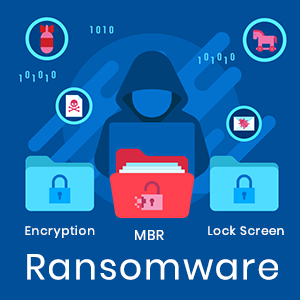Different Types of Ransomware
Different Types of Ransomware
Do you know Different Types of Ransomware ?

Types of Ransomware
Call us for Decryption Services in Nairobi Kenya
Type of malware (malicious software) that locks your computer screen and prevents you from accessing your files and asks you to pay a certain … The most debated topics in the IT world today is about Ransomware. Case study that caused this was the large-scale impact caused by the WannaCry ransomware which happened to cripple many businesses across the world. The most annoying thing about Ransomware is the constant repackaging and evolving by hackers making them very hard to keep track of the latest versions or strains of ransomware.
Do you know each variant of ransomware has its own way of spreading, and heavily rely on social engineering tactics to lure and deceive its users while they hold their critical information or data hostage ( Ransom ) . Allow us to check the various ransomware variants well known now;
CryptoLocker
The CyptoLocker ransomware came into existence in 2013 when hackers used the original CryptoLocker botnet approach in ransomware. It is one of the oldest forms of cyber attacks which has been around for the past two decades.
In terms of destruction to data, CyptoLocker ransomware is on of the most form of ransomware for it makes us of very strong encryption algorithms. More than often proves to be impossible to decrypt (restore) the Crypto ransomware-infected computer and files without paying the ransom.
WannaCry
The WannaCry ransomware has a history of infecting more than 125,000 organizations in the globe. Its alternative names given to the WannaCry ransomware are WCry or WanaCrypt0r. It is by far the most widely known ransomware variant across the globe.
Bad Rabbit
Bad Rabbit first infection was across Russia and Eastern Europe and spreads through a fake Adobe Flash update on most compromised websites.
Cerber
Running any cloud-based Office 365 as a user Cerber is the ransomware variant which will target you. An elaborate phishing campaign to the Millions of Office 365 users was carried out by the Cerber ransomware to form as the target prey.
Crysis
Crysis is the most annoying type of ransomware that encrypts files on fixed drives, removable drives, and network drives , you just get stack. Mode of infection or spreads are through malicious email attachments that have double-file extension, be on the Look out. Why its hated is because of use of a strong encryption algorithms making the owner have a difficult operation of services and request for its decrypt time delays you.
CryptoWall
This is an advanced form of CryptoLocker ransomware. First sited in 2014 immediately after downfall of the original CryptoLocker variant. This days it has multiple variants of CryptoWall in existence that is CryptoDefense, CryptoBit, CryptoWall 2.0, and CryptoWall 3.0.
GoldenEye
Similar to the infamous Petya ransomware. Mode of spreading is by massive social engineering campaign which targets ( HR ) human resources departments. When a user ( HR) etc, downloads the GoldenEye-infected file, silently it auto start a macro that will encrypt files on the (users) victim’s computer device.
Jigsaw
When you have a timer to finish your data then this is the variant. Jigsaw is the most destructive types of ransomware that encrypts and slowly and systematically deletes all the encrypted files until a ransom is paid. The deletion process for the files is hourly basis until the 72-hour mark- when all the remaining files are deleted.
Locky
You can call it the invoice ransomware. Usually spreads through email message disguised as an invoice. Locky locks the victim’s computer and prevent them from using it.
How this infection takes place. When a victim opens the invoice email attachment, it gets deleted automatically and are directed to enable macros to help read the documents and once they enable, Locky starts to encrypt multiple file types using the AES encryption.
Other variants known are , Petya, NotPetya, TeslaCrypt, TorrentLocker, ZCryptor, etc., just know they are designed for malicious activities.
How do you prevent Ransomware ?
Make sure you follow the below
- Install SSL for Websites
- Practicing safe computing habits and by using up to date security software ( Antiviruses )
- Do your part by remaining vigilant and install trusted security software.
- Make sure you don’t open or download email attachment that you know you do not know the sender.
For more details about East African Data Handlers Ransomware Recovery Services ( Decryption Services ) contact us at info@datarecovery.co.ke or +254 711 051 000
All Categories
- Backup
- BUSINESS EMAIL COMPROMISE ATTACKS
- Cloud back up services in Kenya
- Cloud Computing
- Computer Forensics
- Cyber Attacks
- Data Loss
- Data Recovery
- Data Recovery Contacts
- Data Recovery Cost
- Data Recovery In Mombasa
- Data recovery in Nairobi
- Data recovery in South Sudan
- Data recovery in Uganda
- Data Recovery Kenya
- Data Recovery Rwanda
- Data RecoveryKenya
- Database Recovery
- Design
- Desktop Recovery
- DIGITAL FORENSIC LABORATORY(DFL)
- Digital Forensics
- Digital Forensics Kenya
- Digital Photo Data Recovery
- Email Data recovery
- Hacking
- hardriver Recovery
- Laptop Data recovery
- Mobile Data recovery
- Network and Security Services
- Phone Data Recovery
- Raid Data recovery
- Raid Recovery In Kenya
- Ransomware
- Ransomware Attacks
- Ransomware Removal Services
- Server Recovery
- Services
- Technology
- Uncategorized
- Virtual PBX Cloud Services
- Virus & Malwares




